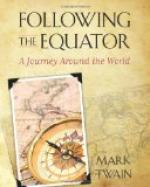His special interest was the fauna of Australasia, and his knowledge of the matter was as exhaustive as it was accurate. I already knew a good deal about the rabbits in Australasia and their marvelous fecundity, but in my talks with him I found that my estimate of the great hindrance and obstruction inflicted by the rabbit pest upon traffic and travel was far short of the facts. He told me that the first pair of rabbits imported into Australasia bred so wonderfully that within six months rabbits were so thick in the land that people had to dig trenches through them to get from town to town.
He told me a great deal about worms, and the kangaroo, and other coleoptera, and said he knew the history and ways of all such pachydermata. He said the kangaroo had pockets, and carried its young in them when it couldn’t get apples. And he said that the emu was as big as an ostrich, and looked like one, and had an amorphous appetite and would eat bricks. Also, that the dingo was not a dingo at all, but just a wild dog; and that the only difference between a dingo and a dodo was that neither of them barked; otherwise they were just the same. He said that the only game-bird in Australia was the wombat, and the only song-bird the larrikin, and that both were protected by government. The most beautiful of the native birds was the bird of Paradise. Next came the two kinds of lyres; not spelt the same. He said the one kind was dying out, the other thickening up. He explained that the “Sundowner” was not a bird it was a man; sundowner was merely the Australian equivalent of our word, tramp. He is a loafer, a hard drinker, and a sponge. He tramps across the country in the sheep-shearing season, pretending to look for work; but he always times himself to arrive at a sheep-run just at sundown, when the day’s labor ends; all he wants is whisky and supper and bed and breakfast; he gets them and then disappears. The naturalist spoke of the bell bird, the creature that at short intervals all day rings out its mellow and exquisite peal from the deeps of the forest. It is the favorite and best friend of the weary and thirsty sundowner; for he knows that wherever the bell bird is, there is water; and he goes somewhere else. The naturalist said that the oddest bird in Australasia was the, Laughing Jackass, and the biggest the now extinct Great Moa.
The Moa stood thirteen feet high, and could step over an ordinary man’s head or kick his hat off; and his head, too, for that matter. He said it was wingless, but a swift runner. The natives used to ride it. It could make forty miles an hour, and keep it up for four hundred miles and come out reasonably fresh. It was still in existence when the railway was introduced into New Zealand; still in existence, and carrying the mails. The railroad began with the same schedule it has now: two expresses a week-time, twenty miles an hour. The company exterminated the moa to get the mails.




